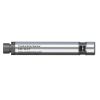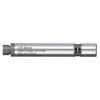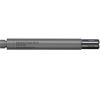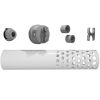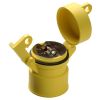HOBO MX800 Series Water Data Loggers
Features
- Submersible and direct read options available
- Wireless data offload via Bluetooth 5.0 and HOBOconnect mobile app
- Water detect feature indicates when logger was out of the water
- Free ground shipping
- Expedited repair and warranty service
- Lifetime technical support
- More
Overview
HOBO MX800 Series wireless data loggers work with interchangeable sensors to provide a highly configurable solution for monitoring water conductivity/salinity, temperature, level, and dissolved oxygen. Available in both an easy-to-deploy, fully submersible model (MX801) and a direct read model (MX802) for convenient data offload that doesn’t require having to remove sensors from the water.
Features
- Compatible with interchangeable Conductivity, CTD (conductivity/temperature/depth), and DO sensors (sold separately) - swap out sensors for different applications
- Bluetooth, for easy logger configuration and data offload
- Easy to deploy, fully submersible (MX801)
- Direct read for convenient data offload (MX802)
- Logger diameter is less than 2 inches
- Faster data offload via Bluetooth 5.0
- Water detect feature indicates when logger was out of the water (MX801)
- Barometric pressure sensor included (MX802)
- Connect two sensors to one logger to get measurements like salinity adjusted DO directly, with no need for post processing
- Guided calibration ensures accurate data
- User-replaceable batteries
| MX801 and MX802 | |
| Operating Range | -40° to 50°C (-40° to 122°F), cannot be frozen in ice |
| Radio Power | 1 mW (0 dBm) |
| Transmission Range | Approximately 30.5 m (100 ft) line-of-sight |
| Wireless Data Standard | Bluetooth 5 |
| Maximum Number of Sensors | 2 |
| Maximum Cable Length | 120m (400 ft) |
| Logging Rate | 5 second to 18 hours |
| Logging Modes | Fixed interval (normal or statistics), burst, or multiple intervals with up to 8 user-defined logging intervals and durations, with pause and repeat options |
| Start Modes | Immediate, next interval or date & time |
| Stop Modes | Memory full, never stop (overwrite oldest data), date & time, or after a set logging period |
| Water Detect | Events are logged when logger is submerged or removed from the water (MX801 only) |
| Time Accuracy | ±1 minute per month 0° to 50°C (32° to 122°F) |
| Battery | Four AA, 1.5 V lithium batteries, user replaceable |
| Battery Life | With W-CTD or W-CT sensors: 2 years, typical with 1-minute logging interval or slower |
| With W-DO sensor: 1-year, typical with 5-minute logging interval or slower | |
| Faster logging or statistics sampling intervals, entering burst logging mode, excessive readouts, and remaining connected with the app will impact battery life | |
| Memory | 730,000 measurements, divided between channels (4 Mbyte memory) |
| Data Download Time (Bluetooth 5) | Full memory: Approximately 3.5 minutes |
| 120,000 measurements: 1 minute | |
| May take longer the further the device is from the logger | |
| Dimensions | Logger diameter: 4.14 cm (1.63 inches) |
| Length without sensor: 20 cm (8 inches) | |
| Length with W-CTD sensor: 36 cm (14 inches) | |
| Length with W-CT sensor: 33 cm (13 inches) | |
| Mounting loop: 12.7 x 22.6 mm (0.5 x 0.89 inches) | |
| Weight | Approximately xx g (xx oz) in air; approximately xx g (xx oz) in saltwater |
| Wetted Materials | Logger: PVC housing with polyester film label, PET sensor connector end cap and mounting handle with EPDM and Buna-N O-rings, passivated 316 stainless steel hardware rated for use in saltwater; MX802 also has ePTFE vent |
| Collar: HDPE, titanium screws | |
| Note: logger should be mounted so that no metal parts of the logger are in contact with other metals | |
| Environmental Rating | MX801: IP68; waterproof to 100m (with sensor(s) attached) |
| MX802: IP67, NEMA 6; Weatherproof (with cable or Termination Plug attached); this model is not waterproof | |
| MX802 Barometric Pressure | |
| Measurement & Calibrated Range | 66 to 107 kPa (9.6 to 15.5 psia), -20° to 50°C (-4° to 122°F) |
| Accuracy* | Typical error: ±0.2 kPa (0.029 psi) |
| Maximum error: ±0.5 kPa (0.073 psi) | |
| Resolution | <0.01 kPa (0.0015 psi) |
| Pressure Response Time** | <1 second to 90% at a stable temperature |
| Contribution to Water Level Accuracy*** | Typical error: ±0.075% FS, 0.3 cm (0.01 ft) water |
| Maximum error: ±0.15% FS, 0.6 cm (0.02 ft) water | |
| *Pressure Accuracy: Absolute pressure sensor accuracy includes all sensor drift, temperature, and hysteresis-induced errors. | |
| **Changes in Temperature: Allow 20 minutes in water to achieve full temperature compensation of the pressure sensor. There can be up to 0.5% of additional error due to rapid temperature changes. | |
| ***Water Level Accuracy: With accurate reference water level measurement, known for water density, and a stable temperature environment. System Water Level Accuracy equals the sum of the Barometric Water Level Accuracy plus the selected CTD sensor Water Level Accuracy. | |
- (1) HOBO MX800 data logger
- (1) Coupler
- (1) 3/32" Allen wrench
In The News
Monitoring Habitat Suitability and Water Quality in Northwest Arkansas Springs
Northwest Arkansas has seen an economic, industrial, and population boom in recent years as a result of expanding businesses, which have created thousands of jobs in the region and the mass migration of employees and construction companies. However, with this growth has come rapid urbanization and the degradation of the natural landscape, specifically the freshwater springs that can be found throughout the region. These springs are critical habitat centers for native wildlife, home to threatened and endangered fish, and those that have yet to be listed. Zach Moran, Assistant Professor of Fisheries Science at Arkansas Technical University, is working to help monitor these habitats and provide key data that will hopefully inform future development in the region.
Read MoreFrom Paddles to Phytoplankton: Studying Vermont’s Wildest Lakes
For six months of the year, Rachel Cray, a third-year PhD student at the Vermont Limnology Laboratory at the University of Vermont, lives between a microscope and her laptop, running data. For the other six months, she is hiking and canoeing four of Vermont’s lakes, collecting bi-weekly water samples. Cray studies algal phenology across four lakes in Vermont, US, that have low anthropogenic stress—or in other words, are very remote. Funded by the National Science Foundation Career Award to Dr. Mindy Morales, the lakes Cray researches part of the Vermont Sentinel Lakes Program, which studies 13 lakes in the area and, in turn, feeds into the Regional Monitoring Network, which operates in the Northeast and Midwest US.
Read MoreReimagining Water Filtration: How Monitoring and Science Enhance FloWater Filtration Systems
Over 50% of Americans think their tap water is unsafe , according to the Environmental Working Group (EWG). Other recent surveys have found that number to be as high as 70% of persons surveyed. Whether due to increased public awareness of water quality issues or confusion about how municipal water sources are regulated, there is a clear distrust of tap water in the United States. According to industry expert Rich Razgaitis, CEO and co-founder of the water purification company FloWater, this issue creates a damaging cycle. Razgaitis explained that the health and environmental problems associated with contaminated water aren’t the only issues. As people become increasingly aware that some tap water is unsafe, they resort to bottled water.
Read More






























